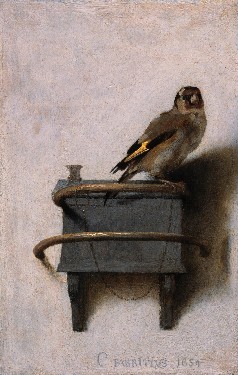
From third to first place. The Goldfinch by Carel Fabritius, c. 1654.
In the bestseller The Goldfinch the New York Metropolitan Museum is bombed and 13-year-old Theo Decker finds himself under a pile of rubble. He and mom were visiting an exhibit of Dutch Golden Age painters. Mom is killed by the blast. A dying man gives the shell-shocked Theo a painting, The Goldfinch by Carel Fabritius. And so an art felon is made. Theo ends up with family in the desert city Las Vegas, something of a juvenile delinquent, and then as an adult in the canal city Amsterdam as part of the underworld of art felons. Donna Tartt’s book is a red hot story about an obsession with a tiny painting and, The Guardian newspaper’s Kamila Shamsie summarizes, about ‘betrayal, suspicion, double-dealing and shoot-outs.’
Back in the real world, Fabritius’ avian house pet, chained to a metal perch on the wall, is safely in the Mauritshuis, in The Hague. With Tartt’s book the painting has surged in popularity and has become a phenomena, like the painting down the hall, Vermeer’s Girl with a Pearl Earring.
Before the book came out Mauritshuis asked visitors to vote on their three favorite paintings and The Goldfinch came in third. Read on for the most popular eight paintings.
The Dutch were the Shit in the 17th century
The Netherlands is too tiny a land, but in the 17th century it was the global shit. The Royal Picture Gallery Mauritshuis is there to show us why. The museum claims that ‘we share the best of Dutch Golden Age painting in our house,’ and it is true. The paintings hang on the walls of a gorgeous and cosy mini-palace Prince Johan Maurits built on returning from Brazil in the early 1600s. The prince schlepped a ton of dark wood back with him to panel the walls of his future home. In the 600-year old rooms you can gaze at the best works of Dutch and Flemish artists who were busy arting at the height of Dutch power and wealth.
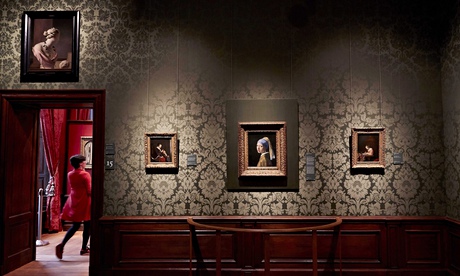
Atmospheric rooms. By Ronald Tilleman, courtesy of Mauritshuis.
The museum opened to the public in 1822. Think about it, at the time the US had 1.5 million slaves and it would be another forty years before the civil war, the Ashanti had just wiped out British forces holding Ghana’s ‘Gold Coast’ and enforced a forty year peaceful co-existence, and the poorly thought-out coffee ban in Sweden was about to end.
Yep, Sweden’s King Gustav III in the late 1700s convinced himself that coffee and tea were poison and banned the stuff. To prove his point he ran a shoddy scientific experiment – one convicted murderer was ‘forced’ to drink coffee everyday until he died, and another tea. Apparently no one was forced to not drink coffee or tea daily until they died, so there was no control group. This being Sweden, maybe they had run out of murderers. Two doctors oversaw the experiment. Both doctors and Gustav III died before the caffeinated prisoners. This science notwithstanding, coffee continued to be banned off and on until the opening of Mauritshuis in the1820s.
Back in Golden Age Holland, the masters loved painting everyday scenes of household turmoil, intimate portraits of working people, some cattle, and loads of flat landscapes. There is a quota of portraits of the rich and powerful, since they paid the bills, but these works don’t dominate. Paintings by Vermeer, Rembrandt, Rubens, Jan Steen and Frans Hals hang alongside Fabritius’ goldfinch. The inspiration for Wes Anderson’s grand deception in Grand Hotel Budapest, the fake Boy with Apple, are there: German artists Lucas Cranach the Elder and Hans Holbein the Younger
Youth and Beauty are Always the Most Popular
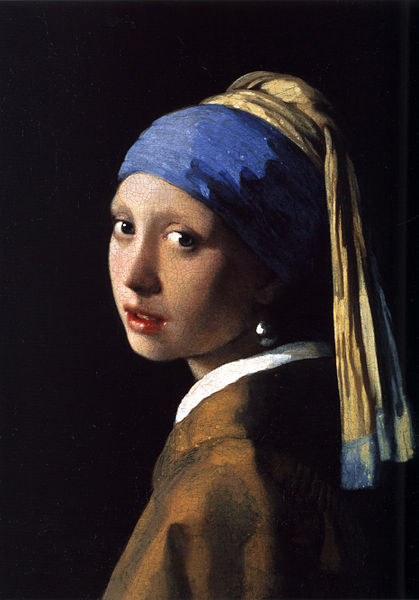
No. 1 most popular work. Girl with a Pearl Earring by Johannes Vermeer, c. 1665.
Ever since the lovely, 2nd generation Danish-Russian actress, Scarlett Johansson played Griet in Girl with a Pearl Earring (2003), it has been impossible to separate painting and movie. And so much has been written about the painting that there’s nothing left to say. Really.
There is a little movie called Tim’s Vermeer, which is a gem. Teller, the oversized illusionist from Penn and Teller (the one who talks) is the narrator and gives a fun look in on an intense art imbroglio — did old masters like Vermeer use a clever new gadget, the camera obscura, to make their hyper-realistic accurate paintings? Tim is completely talentless Texan inventor Tim Jenison. He decides to paint a Vermeer using a camera obscura, and comes out surprisingly well. The film suggests that some of the great works of the 17th century were made with the help of smoke and mirrors. Well, with optical trickery using mirrors and lens. Good to know there were techie artists back then as well.
No. 2 Hipster Doctors and One Dead Convict
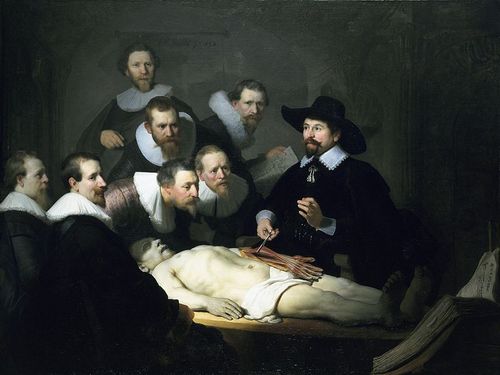
The anatomy lesson of Dr Nicolaes Tulp by Rembrandt van Rijn, 1632.
The Mauritshuis website has uniquely interesting blurbs for many of their paintings and, for the sake of less dishonesty on my part, let me say that the text below is a riff on the work of the museum’s clever staff.
The 2nd most popular painting has a poor convicted, a career criminal, being dissected by the boss of the Amsterdam Guild of Surgeons. Dissections were a serious civic affair and impeccable dress and hipster beards were mandatory. The Guild allowed one dissection of a criminal a year. Criminals had to be executed first, usually on the morning of the cutting. Dr. Tulp, Amsterdam’s anatomist-in-chief and head of the Guild, thought it would be nice to decorate the boardroom of the association with a dissection. He drafted a promising 27-year old Rembrandt to make the portrait. Young Rembrandt was enterprising and he charged each of the seven doctors’ leaning over Dr. Tulp a fee to be included in the painting.
In third, trick performing bird, The Goldfinch
We’ve been through this already. Four hundred plus years ago paintings like The Goldfinch were very popular among the Dutch because they livened up the small and dark homes of the time. Those with enough money had real life Goldfinches, which performed tricks when guests came to visit. The less rich bought painting like The Goldfinch to create the illusion that they to had a real live trick performing bird. From a distance, in a poorly lit room, it works.
No. 4 Wizen Old Master
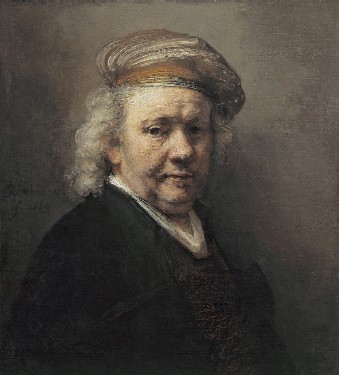
No.4 Self-portrait by Rembrandt van Rijn, c. 1669.
Rembrandt returns is back at 4. He made a huge number of self-portraits, around 80 paintings and sketches, and they document pretty much his whole life. Once he was famous they were apparently also a good business.
This is the last self-portrait, made a year before he died. His skin looks pale and thin, and the look is weary, but the guy is all there and undefeated by a pretty rough life. Rembrandt kept experimenting with his paints and created masterpieces up until the very end.
No.6 Apples, Dromedaries, and Donkeys
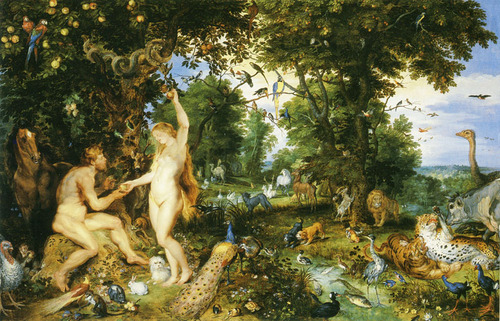
The Garden of Eden with the fall of man by Jan Brueghel the Elder with Peter Paul Rubens, c.1615.
Two heads are better than one and artists often work together to make art. Brueghel the Elder was just great at painting animals and landscapes and Rubens’ thing was full figured people, especially those in Greek myths and the bible. Superstar artists in Antwerp and good friends, they naturally said, hey, why not paint some shit together. And they did – 25 paintings in all. Rubens was a serial collaborator and worked with all sorts of people.
For a painting of the original sin, The Garden of Eden has a distractingly large number of animals. While Eve is tempting Adam with that damn apple, there’s a wildly unlikely assortment of monkeys, dromedaries and an elephant. Parrots, a peacock, a bird of paradise and an ostrich share space with a lion, tiger and leopard, and peacefully hanging about with cattle and deer. No clash of eco-systems in Paradise since we were all still getting along.
No.7 Sinning at Home with the Kids
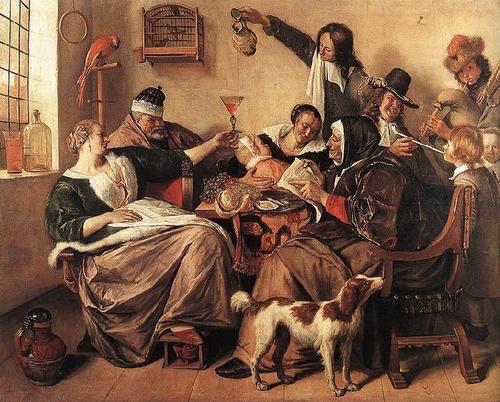
The way you hear it, is the way you sing it by Jan Steen, c.1665.
Jan Steen liked a good proverb and this painting is for ‘as the old sing, so pipe the young’ (soo voer gesongen, soo na gepepen). The rough English version is ‘He who sins before a child, sins double.’
Steen also liked a good laugh, including at the expense of his entire family. Here his very own kids are ‘piping,’ imitating the vices of the adults. Steen is merrily lighting his son’s pipe, another of his kids is playing the bagpipes (a minor vice), and a full-bodied lady, Grietje van Goyen, the mother of his children, and going in for a refill of, let’s say, wine. A pleasantly soused and near-sighted granny is singing from a sheet of music and the grandfather watches the whole thing with sleepy amusement.
No.8 No Ordinary Bull
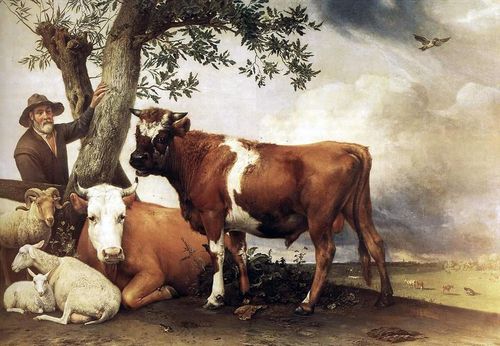
The Young Bull by Paulus Potter, c. 1647.
The Young Bull was a huge hit when it first came out and continues to draw crowds today. The tween bos taurus is the central personage in the painting. The whole thing is way ahead of its time: the Young Bull not only has a great patch of land and a dotting mother, but his own pet sheep and farmer. According to the Mauritshuis, ‘glorifying cattle to this extent was something that happened only in Holland’ in the 17the century.’ Why the Dutch were so mad about their farm animals I really don’t know. But there you have it. The Young Bull made Potter famous at 21.
Extra Blog Stuff: Who is Maurits of Mauritshuis
The Golden Age produced the first truly multi-national company, the West India Company, which had its own army to guarantee the money kept coming in. The Dutch government of the day gave the Company the Atlantic slave trade and parts of Brazil, the Caribbean, and North America to run.
The rich merchants on the Company’s board knew a good thing when they say it and Maurits of Nassau was a star. They made him Governor General of a vast area of Northeastern Brazil, taken from the disorganized Portuguese.
The man was way way ahead of his time. He landed there with a troop of soldiers, scientists, and painters, and built a Mauritsstadt, a new capital, that had an orphanage, hospital, zoo and even botanical gardens. A good Amsterdammer, Maurits guaranteed religious freedom, or at least tolerated it, and ever the trader became buddies with the Tapuya indigenous peoples, rather then enslaving or slaughtering them.
Maurits had no problem spending the Company’s money and in the first seven years as Governor General burnt through a small fortune. The Company’s sour board was not amused. It refused further request for funds and then called him back to the Netherlands. When he got back home he built Mauritshuis.
A more sorry specimen contributed the original collection to the museum. William V, Prince of Orange-Nassau, was Stadtholder [head of state] of the Dutch Republic a few years after Maurits passed. He first supported the British against the freedom fighters in the American War of Independence. He was then on the losing side of a war after the French Revolution. He had to flee to London, and then tried to run the Dutch Republic from across the Channel. Worse, he led a failed Anglo-Russian invasion of Holland (?!).
At that point the Dutch really weren’t to keen on him and he died in exile in what is now Germany. They only brought his body home to Holland 200 years later, in 1958.
For all that, without both Johan Maurits and William V there would probably be no Mauritshuis museum and who knows what might have happened to the Goldfinch.
Sources
- Bennett Alan Weinberg, Bonnie K. Bealer, The World of Caffeine: The Science and Culture of the World’s Most Popular Drug. Psychology Press 2001.
- David Hockney, Secret Knowledge: Rediscovering the Lost Techniques of the Old Masters. 2001
- http://boingboing.net/2014/06/10/vermeers-paintings-might-be.html
- Daniel Cooper, How Tim Jenison created ‘Tim’s Vermeer’
- http://www.designboom.com/architecture/mauritshuis-museum-renovation-ex…
- Mauritshuis Museum Reopens in The Hague Following Extensive Renovation









